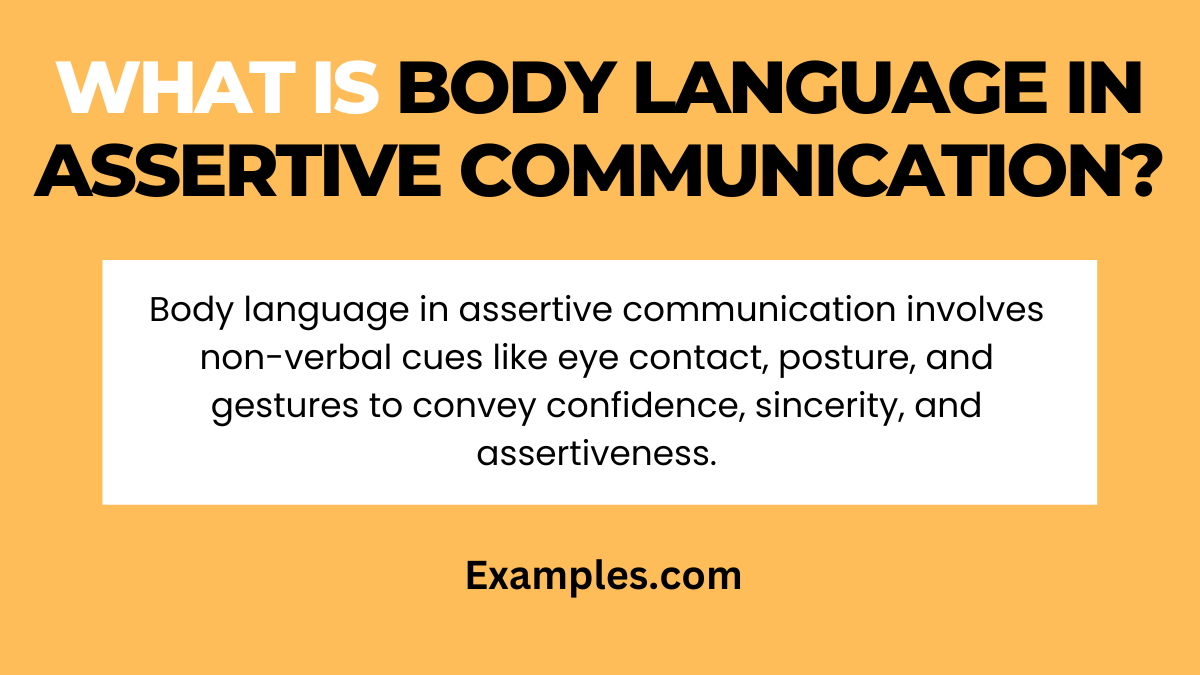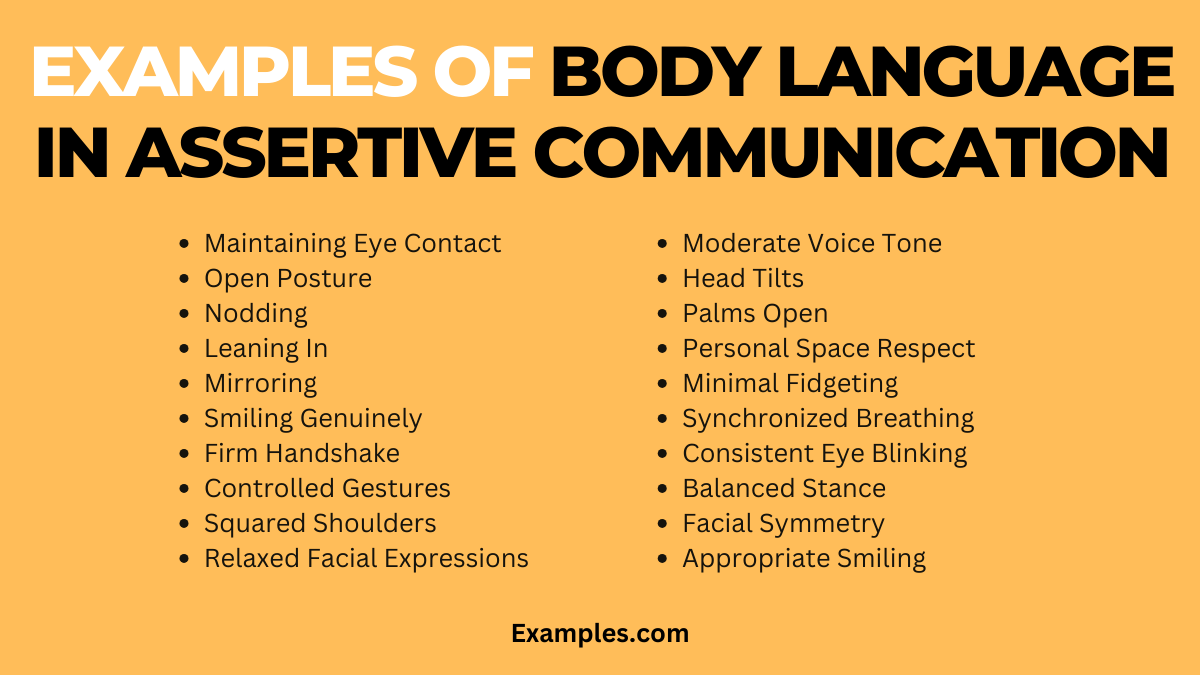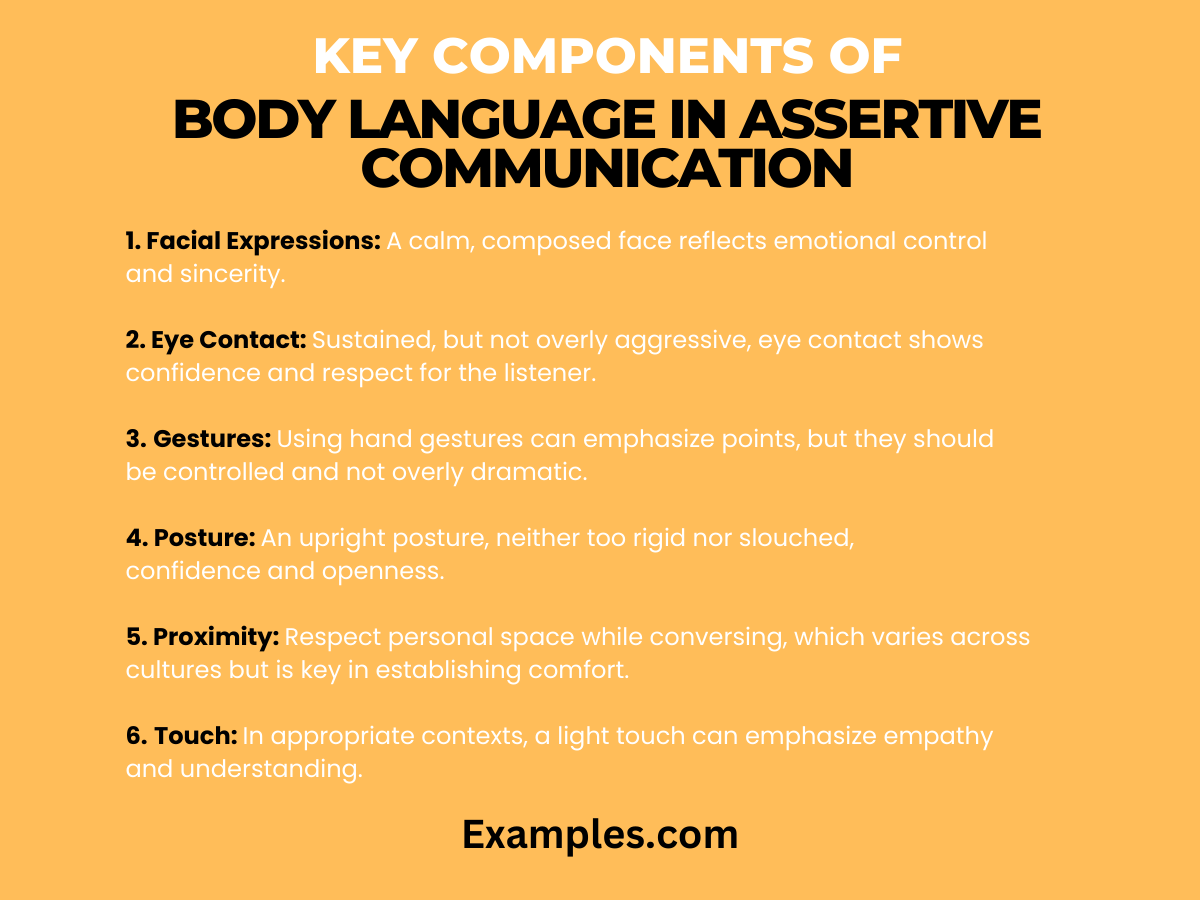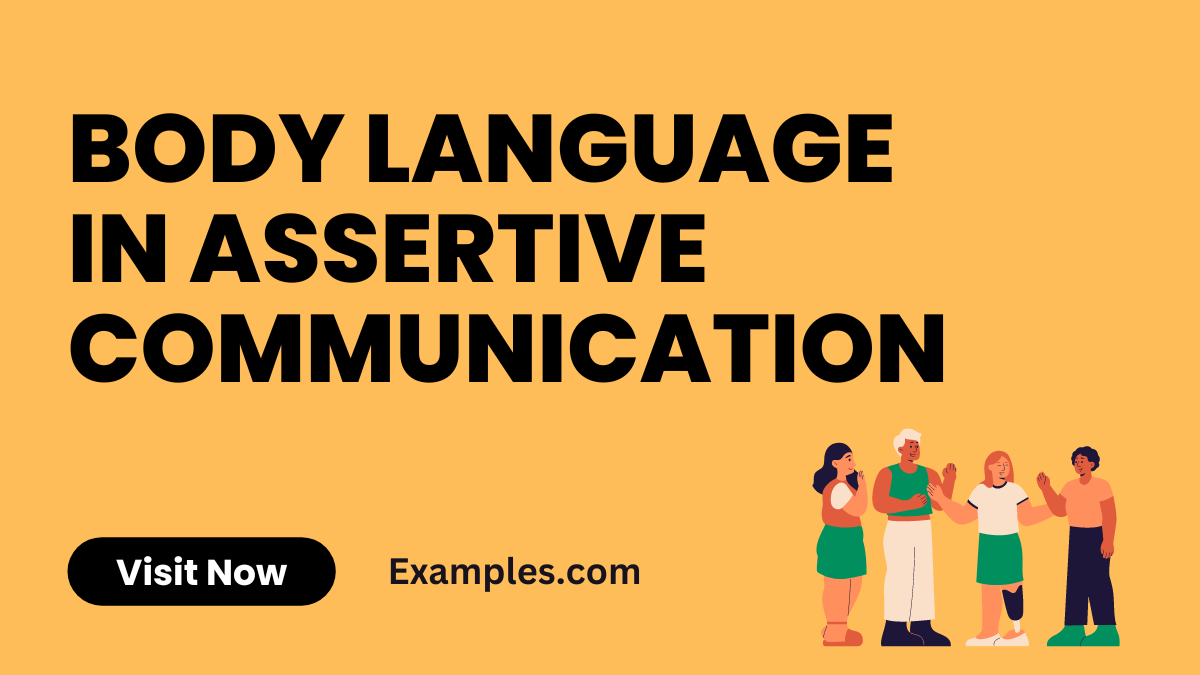19+ Body Language in Assertive Communication Examples
In the realm of Assertive Communication, mastering the art of body language is pivotal. This guide delves into the nuances of body language within assertive communication, offering insightful examples and practical tips. By understanding and applying these concepts, individuals can significantly enhance their communication skills, ensuring messages are conveyed effectively and respectfully. This guide serves as an essential tool for anyone looking to improve their interpersonal interactions in both personal and professional settings.
What is Body Language in Assertive Communication?

Body language in assertive communication refers to the non-verbal cues and gestures that complement verbal messages, reinforcing the speaker’s intentions and emotions. It encompasses elements like posture, eye contact, facial expressions, and gestures, playing a critical role in conveying confidence, respect, and clarity. Understanding and utilizing effective body language can greatly enhance the impact and effectiveness of assertive communication.
What is the Best Example of Body Language in Assertive Communication?

A prime example of body language in assertive communication is maintaining steady eye contact during a conversation. This simple act conveys confidence and sincerity, fostering trust and openness in the interaction. Another key aspect is adopting an open posture, with shoulders back and head held high, which signals self-assurance and readiness to engage. These physical cues, combined with clear verbal expression, epitomize assertive communication, enabling individuals to interact effectively while respecting their own and others’ boundaries.
20 Examples of Body Language in Assertive Communication

Mastering Body Language in Assertive Communication is key to effective interpersonal skills. This guide offers 20 unique and impactful skills, each with a bold example sentence, enhancing your ability to express confidently and respectfully. Embrace these techniques to excel in various scenarios, from the workplace to personal relationships, embodying the essence of Assertive Communication Skills.
- Maintaining Eye Contact: Conveys confidence and sincerity.
Example: “I understand your point, but here’s my perspective,” you say, keeping steady eye contact. - Open Posture: Shows willingness to engage and listen.
Example: Sitting with uncrossed arms, you nod, indicating openness to the conversation. - Nodding: Signals agreement or understanding without interrupting.
Example: You nod subtly as your colleague explains, showing you’re following along. - Leaning In: Indicates interest and engagement in the discussion.
Example: Leaning forward, you say, “Please, tell me more about this.” - Mirroring: Reflects empathy and builds rapport.
Example: You subtly mirror your partner’s gestures, fostering a connection. - Smiling Genuinely: Shows warmth and approachability.
Example: A warm smile accompanies your words, “I’m glad we’re discussing this.” - Firm Handshake: Projects confidence and respect.
Example: Offering a firm handshake, you introduce yourself assertively. - Controlled Gestures: Enhances clarity and emphasis without overpowering.
Example: With deliberate hand gestures, you highlight key points in your argument. - Squared Shoulders: Demonstrates readiness and confidence.
Example: You square your shoulders, prepared to address the challenging topic. - Relaxed Facial Expressions: Indicates calmness and emotional control.
Example: Maintaining a relaxed expression, you calmly address the criticism. - Moderate Voice Tone: Balances authority and friendliness.
Example: “I see your point, but here’s my view,” you say in a measured tone. - Head Tilts: Shows curiosity and engagement.
Example: Tilting your head, you ask, “Can you elaborate on that?” - Palms Open: Signals honesty and transparency.
Example: With open palms, you express, “I’m open to your suggestions.” - Personal Space Respect: Maintains comfort and respect for boundaries.
Example: You consciously maintain a respectful distance while conversing. - Minimal Fidgeting: Portrays focus and composure.
Example: You avoid fidgeting, demonstrating your full attention to the matter. - Synchronized Breathing: Helps maintain emotional balance.
Example: You take a deep breath, aligning your response with calmness. - Consistent Eye Blinking: Avoids intimidation or disinterest.
Example: Your blinking remains consistent, ensuring a friendly demeanor. - Balanced Stance: Exudes stability and confidence.
Example: Standing with a balanced stance, you express your points confidently. - Facial Symmetry: Reflects sincerity and emotional balance.
Example: Your expressions are symmetrical, conveying genuine interest. - Appropriate Smiling: Indicates positivity without undermining seriousness.
Example: You smile appropriately, ensuring the seriousness of the topic is maintained.
Importance of Body Language in Assertive Communication
- Enhances Message Clarity: Effective body language, such as maintaining eye contact and adopting an open posture, clarifies and strengthens the verbal message in assertive communication.
- Increases Persuasiveness: Non-verbal cues like a firm stance and confident gestures can make the speaker more persuasive, thereby enhancing the impact of their assertive communication.
- Builds Credibility: Consistent and confident body language builds credibility, showing that the speaker is sincere and committed to their words.
- Reflects Confidence: Good posture and controlled movements reflect self-confidence, which is crucial in assertive communication.
- Facilitates Active Listening: Appropriate body language, like nodding and maintaining eye contact, indicates that the speaker is actively engaged and values the listener’s response.
- Regulates Emotional Expression: Effective control of facial expressions and gestures helps in appropriately conveying emotions, a key aspect of assertive communication.
- Supports Conflict Resolution: In challenging conversations, body language that demonstrates openness and respect can prevent escalation and aid in resolving conflicts.
- Improves Understanding: Non-verbal cues can aid in better understanding, especially in complex or sensitive conversations where words alone might be insufficient.
How To Develop Assertive Body Language?
- Practice Open Posture: Stand or sit straight with an open chest and relaxed shoulders to convey approachability and confidence.
- Maintain Eye Contact: Eye contact signifies honesty and engagement, important in assertive communication skills.
- Use Gestures Confidently: Controlled and purposeful gestures can emphasize your points and demonstrate conviction in your words.
- Regulate Facial Expressions: Be aware of your facial expressions; they should align with your message and tone.
- Work on Voice Modulation: A clear, steady voice conveys confidence. Avoid a monotonous tone to keep the listener engaged.
- Practice in a Safe Environment: Role-play assertive communication scenarios with a friend or in front of a mirror.
- Seek Feedback: Ask for feedback on your body language from trusted individuals and be open to making adjustments.
- Stay Aware of Cultural Differences: Understand that body language can vary significantly across cultures; adapt your non-verbal communication accordingly.
Key Components of Body Language in Assertive Communication

- Facial Expressions: A calm, composed face reflects emotional control and sincerity.
- Eye Contact: Sustained, but not overly aggressive, eye contact shows confidence and respect for the listener.
- Gestures: Using hand gestures can emphasize points, but they should be controlled and not overly dramatic.
- Posture: An upright posture, neither too rigid nor slouched, communicates confidence and openness.
- Proximity: Respect personal space while conversing, which varies across cultures but is key in establishing comfort.
- Touch: In appropriate contexts, a light touch can emphasize empathy and understanding.
- Voice Tone and Pitch: A clear, steady voice that’s not too loud or soft is effective in assertive communication.
- Timing and Pace: Pausing before responding and speaking at a measured pace allows time for thought and emphasizes your points.
In mastering Assertive Communication, it is crucial to blend both verbal and non-verbal cues effectively. Body Language in Assertive Communication plays a pivotal role, conveying confidence and respect. By maintaining eye contact, adopting an open posture, and using gestures that emphasize your message, you reinforce your words with powerful, non-verbal affirmations. These subtle yet impactful actions support clear, respectful, and direct communication, fostering constructive interactions in various settings. Remember, assertive communication is not just about what you say, but also how you say it, making body language an indispensable tool in this art.



